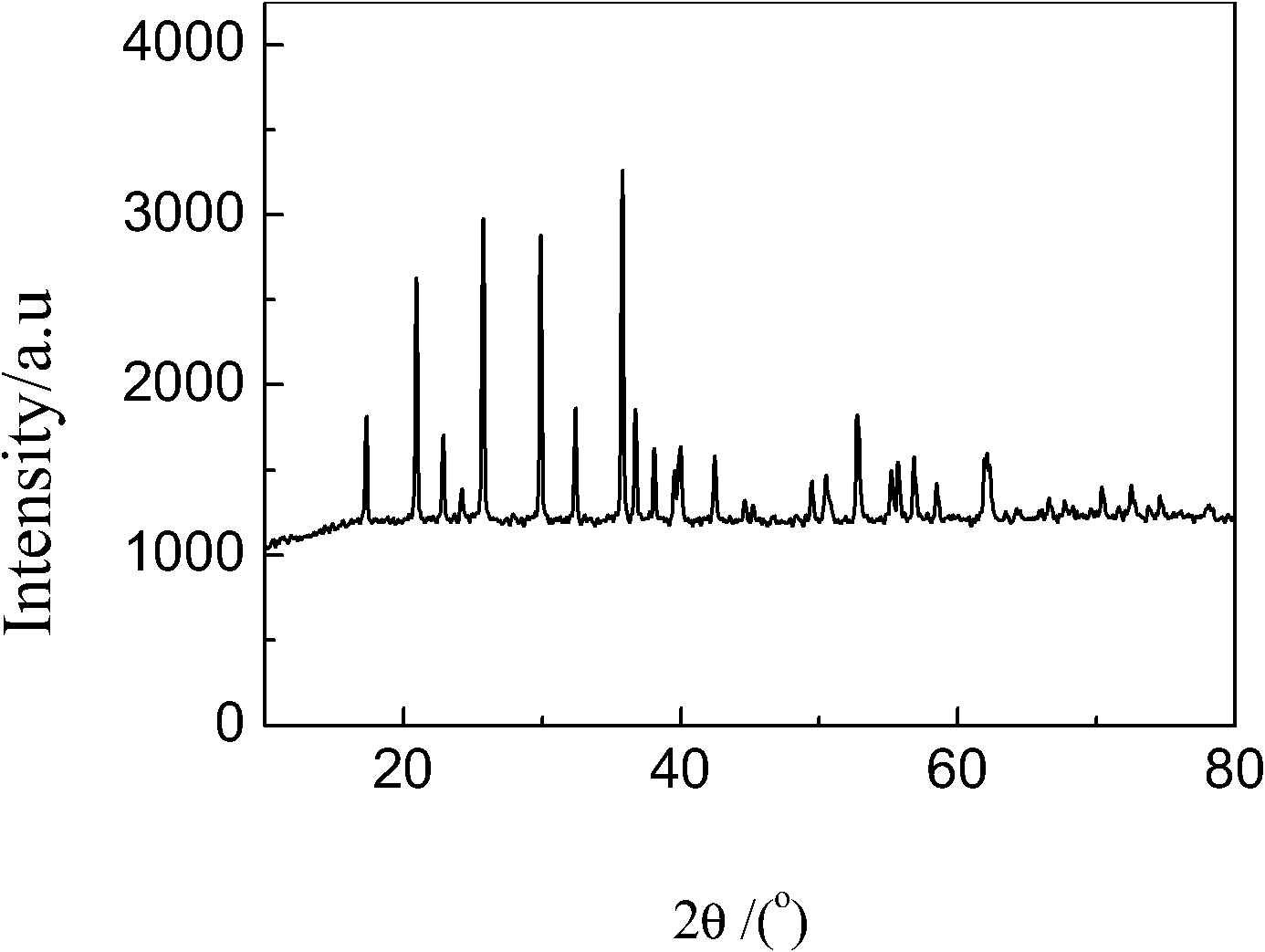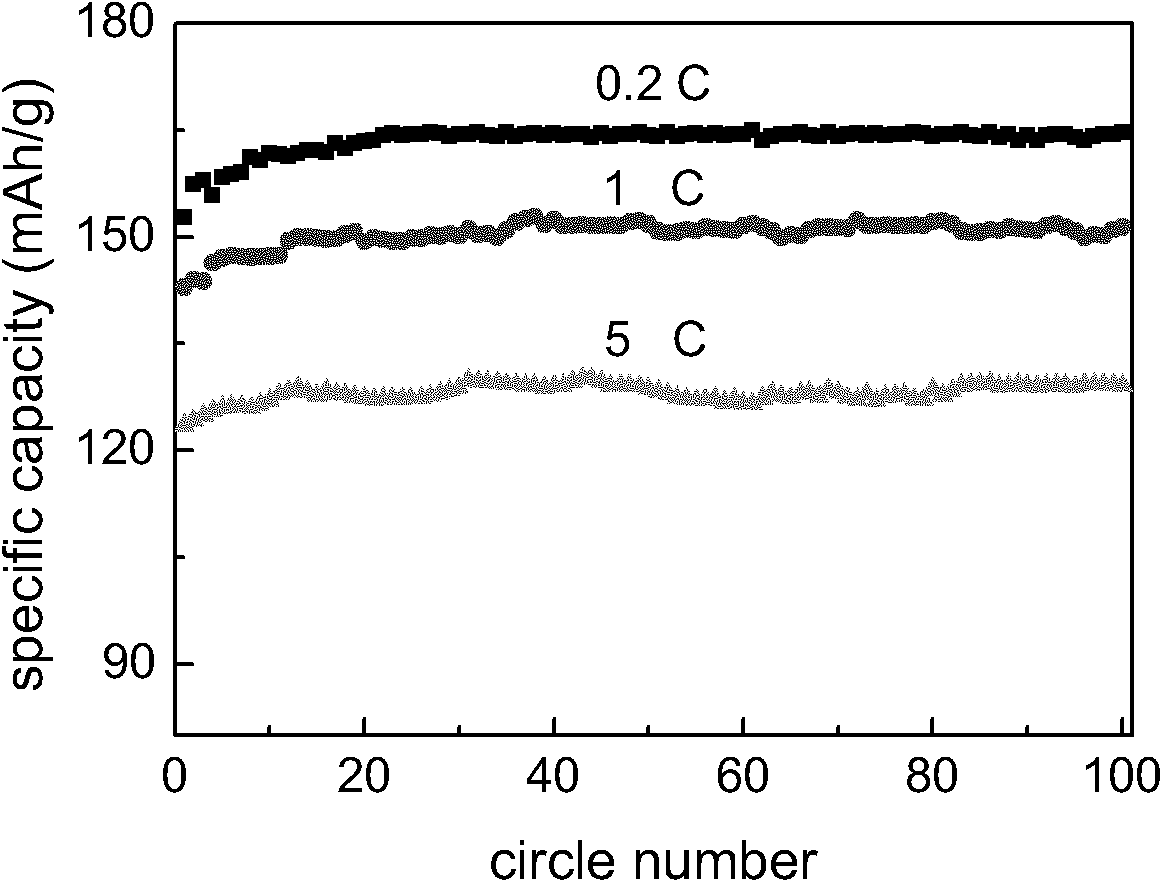Method for preparing lithium iron phosphate compound anode material
A composite cathode material, lithium iron phosphate technology, applied in battery electrodes, electrical components, circuits, etc., can solve the problem that the product quality and process level are not enough to meet the power battery, it is difficult to ensure the overall uniformity of carbon coating and material phase, The problems of low conductivity of lithium iron phosphate can shorten the production cycle, improve the diffusion capacity, and shorten the reaction time.
- Summary
- Abstract
- Description
- Claims
- Application Information
AI Technical Summary
Problems solved by technology
Method used
Image
Examples
Embodiment 1
[0032] A method for preparing lithium iron phosphate composite cathode material, using lithium citrate, ferrous chloride, lithium dihydrogen phosphate, sodium carboxymethyl cellulose as raw materials, and the ratio of the above ingredients is: Li:Fe :P:C=1.2:1:1:1; The method described uses polyethylene oxide as a surfactant;
[0033] The method includes the following steps:
[0034] (1) Add polyethylene oxide and sodium carboxymethyl cellulose to the reaction kettle at 80°C under ultrasonic conditions, add tetraethyl glycol solvent and stir for 3 hours, and then fill with argon;
[0035] (2) Prepare tetraethyl glycol solutions of lithium dihydrogen phosphate and lithium citrate, and add these two solutions to the reaction kettle described in step (1) at the same time, ultrasonic and stirring for 4 hours;
[0036] (3) Prepare a tetraethyl glycol solution of ferrous chloride, add antioxidant 1010, keep stirring, add to the reaction kettle of step (2), ultrasonic and stir for 4 hours, t...
Embodiment 2
[0042] A method for preparing lithium iron phosphate composite cathode material, using lithium hydroxide, ferrous nitrate, phosphoric acid, and β-cyclodextrin as raw materials, calculated by mole, and the above-mentioned ingredients ratio is: Li:Fe:P:C= 0.9:1:1:1; the method described uses polyethylene oxide as a surfactant;
[0043] The method includes the following steps:
[0044] (1) Add polyethylene oxide and β-cyclodextrin to the reaction kettle at 90°C under ultrasonic conditions, add acetonitrile solvent and stir for 3 hours, and then fill with argon;
[0045] (2) Prepare acetonitrile solutions of phosphoric acid and lithium hydroxide, add these two solutions to the reaction kettle described in step (1) at the same time, sonicate and stir for 5 hours;
[0046] (3) Prepare the acetonitrile solution of ferrous nitrate, add antioxidant 2246, stir continuously, add to the reaction kettle of step (2), ultrasonic and stir for 3 hours, the antioxidant, in terms of mass percentage, Th...
Embodiment 3
[0052] A method for preparing lithium iron phosphate composite cathode material, using ferrous citrate, lithium dihydrogen phosphate, and polyvinyl alcohol as raw materials, calculated by mole, and the above-mentioned ingredients ratio is: Li:Fe:P:C=1: 1:1:0.3; the method uses polyethylene oxide as a surfactant;
[0053] The method includes the following steps:
[0054] (1) Add polyethylene oxide and polyvinyl alcohol to the reaction kettle at 90°C under ultrasonic conditions, add glycerol solvent and stir for 2 hours, and then fill with argon;
[0055] (2) Prepare a glycerol solution of lithium dihydrogen phosphate, and then add this solution to the reaction kettle described in step (1), ultrasonically and stir for 5 hours;
[0056] (3) Prepare a glycerol solution of ferrous citrate, add antioxidant 1076, keep stirring, add it to the reaction kettle of step (2), ultrasonic and stir for 3 hours, the antioxidant, according to mass percentage Calculated, its dosage is 0.1% of the iron ...
PUM
 Login to View More
Login to View More Abstract
Description
Claims
Application Information
 Login to View More
Login to View More - R&D
- Intellectual Property
- Life Sciences
- Materials
- Tech Scout
- Unparalleled Data Quality
- Higher Quality Content
- 60% Fewer Hallucinations
Browse by: Latest US Patents, China's latest patents, Technical Efficacy Thesaurus, Application Domain, Technology Topic, Popular Technical Reports.
© 2025 PatSnap. All rights reserved.Legal|Privacy policy|Modern Slavery Act Transparency Statement|Sitemap|About US| Contact US: help@patsnap.com



